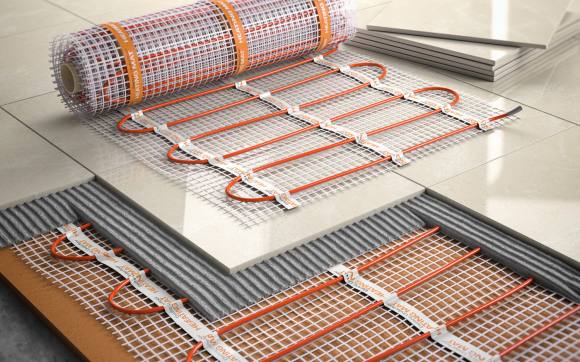Underfloor heating works on the same principle as conventional radiators, only the installation is different. Radiators are placed vertically under the windows. Traditionally, underfloor heating is a large radiator laid on its side: it lies horizontally and covers the entire area. This ensures more even heating of the house. Liquid is supplied to the pipes of the water-based floor system, just as it is to the radiators—usually water, but at a lower temperature than that of the radiators.

Advantages of Underfloor Heating
The main advantages of underfloor heating include the following factors:
-
If the floor area of the house is small, installing underfloor heating eliminates the need to reserve extra space for radiators.
-
With radiator heating, there are restrictions on furniture placement in rooms. For example, you cannot cover a radiator with a cabinet or sofa; in such cases, the radiator heats the furniture instead of the room. Moreover, radiators themselves can reach temperatures of 60–80 °C, which may be dangerous. With underfloor heating, such issues do not arise.
-
Underfloor heating in an existing floor can be very energy efficient: while radiators need to be heated to 60–80 °C, underfloor heating requires only 25–40 °C. This is more than enough to heat the house.
⚠️ Note: It is not recommended to heat underfloor systems above 43 °C, as walking on the floor may become uncomfortable.
How Much Does It Cost to Install Underfloor Heating?
After choosing the type of underfloor heating, you need to determine the installation costs in a private home. These underfloor heating milling costs include both materials and labor. It is important to note that as of early 2025, there are significant price differences in the construction sector, including underfloor heating. Even the same installation technologies can vary in cost depending on the brand.
For electric underfloor heating, electricity may be the only energy source. For water-based systems, the water in the pipes can be heated with electricity, gas, diesel, or a pellet boiler. Moreover, heating with gas can be up to 80% cheaper for the same heated surface area!
FAQ – Frequently Asked Questions
Is it necessary to install a residual current device (RCD) when installing underfloor heating?
Any type of underfloor heating connected to the power grid must be equipped with an RCD. In addition, a separate protection device must be used for each room.
For which rooms is a cable underfloor heating system suitable?
Cable underfloor heating is suitable for living rooms, bathrooms, showers, swimming pools, attics, garages, and utility rooms.
How do you correctly calculate the floor area for installing electric underfloor heating?
When calculating, keep in mind that the distance from the wall must be at least 100 mm. It is not allowed to install cables or heating elements under furniture, household appliances, or sanitary fixtures.
